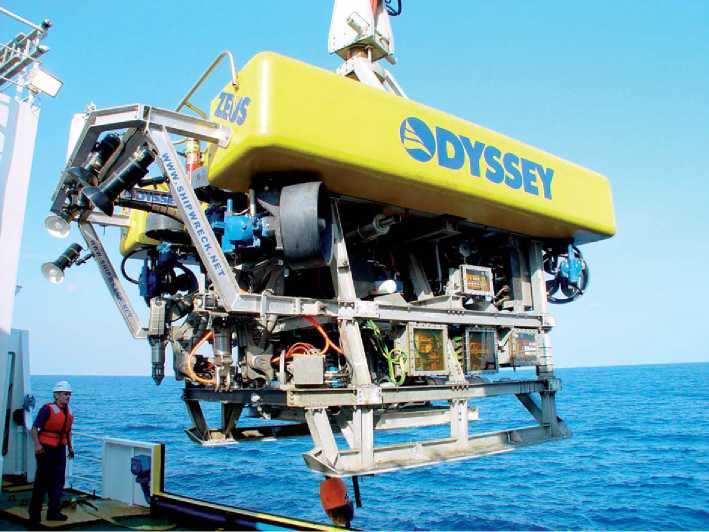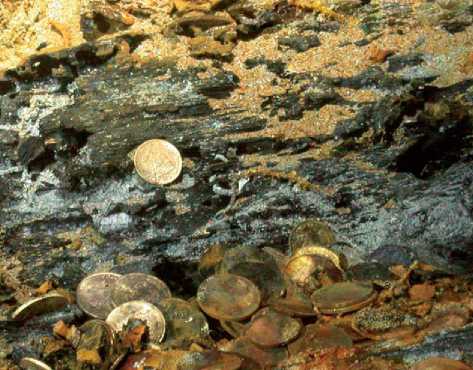All of this technology costs money, as do the ships from which it is deployed, and the skilled crews to operate them. It is a very rare museum, university, or other research institution that has long-term access to such equipment, and those that have it usually have to share it among departments investigating deep ocean geology, biology, hydrology, and other sciences as well as archaeology.
As a result, with very few exceptions, virtually all deep-ocean archaeology today is being carried out

Figure 1 An ROV named ZEUS, the eight-ton, 205 horsepower remotely operated vehicle (ROV) used by Odyssey Marine Exploration, is raised from the Atlantic after a trip 1700 feet deep to the shipwreck of the SS Republic. (Photo credit: Odyssey Marine Exploration).
By commercial marine salvage companies. This fact outrages many traditional archaeologists, who believe that there is no room for accommodation between the interests of archaeology and those of treasure salvage (see Ethical Issues and Responsibilities). Some archaeologists, however, have reached working relationships with shipwreck exploration and salvage companies (Figure 2).
It works like this: the salvage company that wants to recover treasure from a shipwreck enters into a contract with archaeologists, and where law requires it, with government regulatory bodies, under which it is agreed that fieldwork will be performed according to high archaeological standards. Research designs are formulated and approved, and the work is carried out accordingly. What is recovered is divided into two big classes (often with various subdivisions) - one made up of material that must remain together and be cared for as a research collection, the other made up of material that can be sold. The research collection includes the remains of the ship itself, the personal gear of the crew and passengers, elements of the cargo - essentially, everything from which much can be learned about the ship, its people, and the times in which it operated. The marketable collection includes coinage, bullion, sometimes other manufactured material like bottles and other goods recovered from

Figure 2 Coins on seabed. (Photo credit: Odyssey Marine Exploration).
The shipwreck in large quantity. Sometimes things like coal from a ship’s engine room are offered for sale. Little more can be learned from such material once basic information has been recorded - the dates and types of coins, the weight, shape, purity and surface markings of each gold bar, the type and date of each bottle and what it probably contained - so nothing is lost if it goes into the stream of commerce after archaeological documentation. The more valuable material - coins, for example - is also usually very carefully conserved and graded by companies with expertise in this area, and these companies keep elaborate records, simply because the material is so valuable. If someone someday wants to study all the coins from Shipwreck X, they may find the coins better preserved and more accessible in private hands than they would be in academic study collections.
Arrangements like this make it possible for an ethical archaeologist to cooperate with treasure recovery operations, because the information for which the archaeologist is responsible is collected, conserved, recorded, analyzed, and reported appropriately. The salvage company is able to justify the archaeology to its stockholders - that is, explain why they’re spending money on very careful excavation rather than just grappling the stuff to the surface - because the archaeological work actually increases the commercial value of the material. A well-documented artifact is worth more than one whose provenance is poorly recorded.
But few such collaborations between treasure salvage firms and archaeologists have actually been undertaken, and those that have gone forward have happened largely in shallow waters. In fact, at this writing, Odyssey Marine Exploration Inc. of Tampa, Florida, may be the only company doing deep-ocean archaeology. Most salvage firms still have trouble finding qualified archaeologists who will work with them - so strong are the professional biases against such collaboration. However, it can be predicted that treasure salvage-supported archaeology will increase in the years to come; the treasures are on the seabed, and they are recoverable using technology that with few exceptions only commercial salvage companies can afford.




 World History
World History









